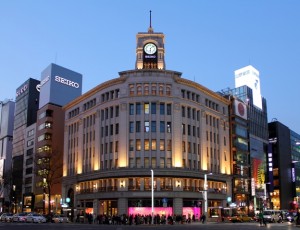‘Antenna Shops’, promoting specialities and produce from the regions and run by Japan’s local authorities, are a common site in the high-end shopping districts of Japan as they continue to rise in number, and can now be seen in cities overseas.
Tokyo and Osaka have seen an increase over the last decade of antenna shops, and the growth of these local authority funded facilities can be seen in other cities as regions in Japan try to promote their areas as a tourist destination and expand markets for goods produced in the prefectures.
The term ‘antenna shop’ is now mainly associated with marketing local produce, and originally meant the outlets established by companies to test drive sales of new products, sometimes with regional branding of which there is a strong tradition in Japan, with various areas famous for particular products i.e. Kyoto for tea, Tokyo for sushi, Fukuoka for ramen noodles etc. Currently antenna shops have developed into centres to promote regions in their own right, offering tourist information as well as acting as meeting points for people originally from the same prefecture (a common Japanese tradition, even in London there are many kenjinkai or ‘expat committees’ for people from Fukushima, Saitama, Akita and many others)
Tokyo was the first to open its own antenna shop in 1991 (perhaps counter-intuitively in the same city, but successful enough to encourage other prefecture to follow), and the trend caught on with the opening of Okinawa and Kumamoto shops in 1994. In July 2014 Tokyo has 61 antenna shops from every region of Japan.
Ginza, Yūrakuchō and Nihonbashi are the most famous shopping areas in Tokyo, the Regent Streets and Carnaby Streets of Japan, and where the antenna shops of the prefectures are mainly operating in the capital. Walking out of one of Tokyo station’s main exits eight or so signs for antenna shops with their regional branding can be seen while walking to the popular Yūrakuchō district with its many izakaya (Japanese pub) and yakatori style grilled meat stands and bars.
One of the busiest antenna shops is ‘Ginza Nagano’, which differs from other antenna shops in its focus on providing information to those looking for a lifestyle change and a better quality of life than can be found in Tokyo. The first floor of the building offers information on property sales in the prefecture, the second floor is an event space, the third a private-managed soba noodle shop (a well known cuisine of the region), while the fourth floor is full of relocation advisors as well as break out spaces for prefectural officials and a co-working space.
While Nagano uses its antenna shop to lure Tokyo weary families away from the capital, many of the other prefecture shops have been so successful they have expanded their operation to target tourists from overseas. Dedicated sections with regional goods are now increasingly common in shops and department stores on the tourist trail. Shops are also seeking to cater to the growing numbers of foreign tourists visiting Japan by selling tax-free products and deploying English-speaking staff. According to the Japan Center for Regional Development, most of the antenna shops in the capital have 100,000–500,000 visitors a year, with the most popular like Hokkaidō and Okinawa, attracting over one million customers to earn from ¥700 million to ¥1 billion in annual sales.
There are also antenna shops established by local authorities outside Japan. In 2009, four prefectures of the island of Shikoku collaborated in setting up a store in Shanghai, targeting new markets for regional products in targeting wealthy Chinese consumers with whom Japanese luxury branded products are increasingly popular. Hokkaidō and the eight prefectures within the Tōhoku region (north east Japan) have collaborated in Hong Kong attracting tourists to the sponsoring prefectures. Niigata Prefecture in Russia opened a Vladivostok store in 2012, then in Khabarovsk in 2013. Experimental “pop-up” shops overseas have been set up by local authorities on a temporary basis: Hokkaidō, Japan’s largest prefecture by area opening one in Singapore, with Ōita Prefecture setting up shop in Wuhan, China.
In February 2015, Japan Council for Regional Development worked together with the major online restaurant guide Gurunavi to produce English-language pamphlets, “Local Speciality Shops 2015,” in preparation for the March launch of the new Hokuriku Shinkansen high-speed train service connecting Tokyo and Kanazawa on the Sea of Japan. As well as providing a map of antenna shops, the pamphlet offers information on restaurants, bars, Wi-Fi, and tax-free stores.
While useful to international visitors, antenna shops are generally run with domestic customers in mind. Now there is increasing focus on tourists from overseas with multilingual staff and websites as well as restaurant menus in advance of events like the 2019 Rugby World Cup and the 2020 Tokyo Olympic and Paralympic Games.
Picture courtesy of Kakidai under Creative Commons Attribution-Share Alike 3.0 Unported licence


